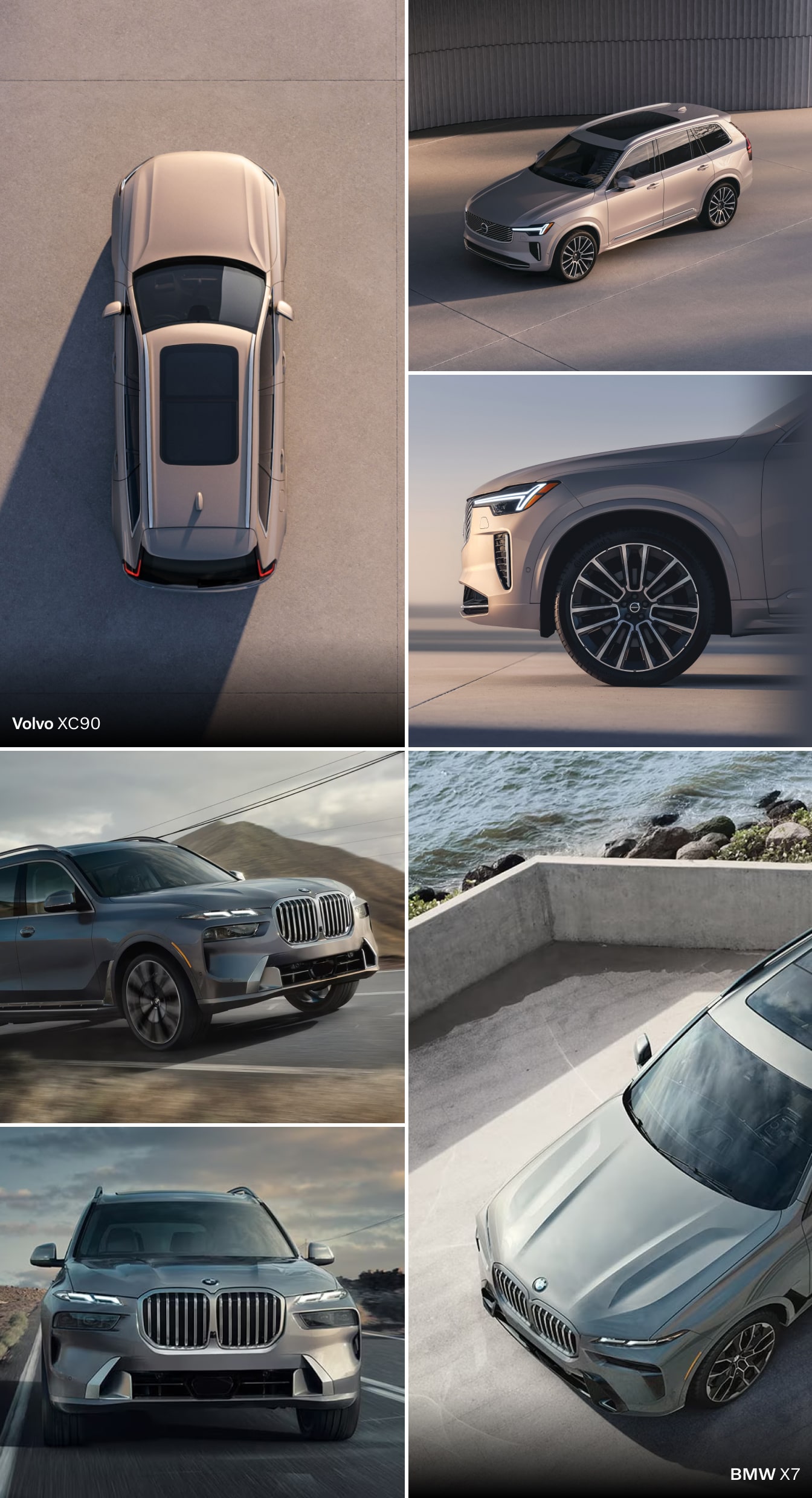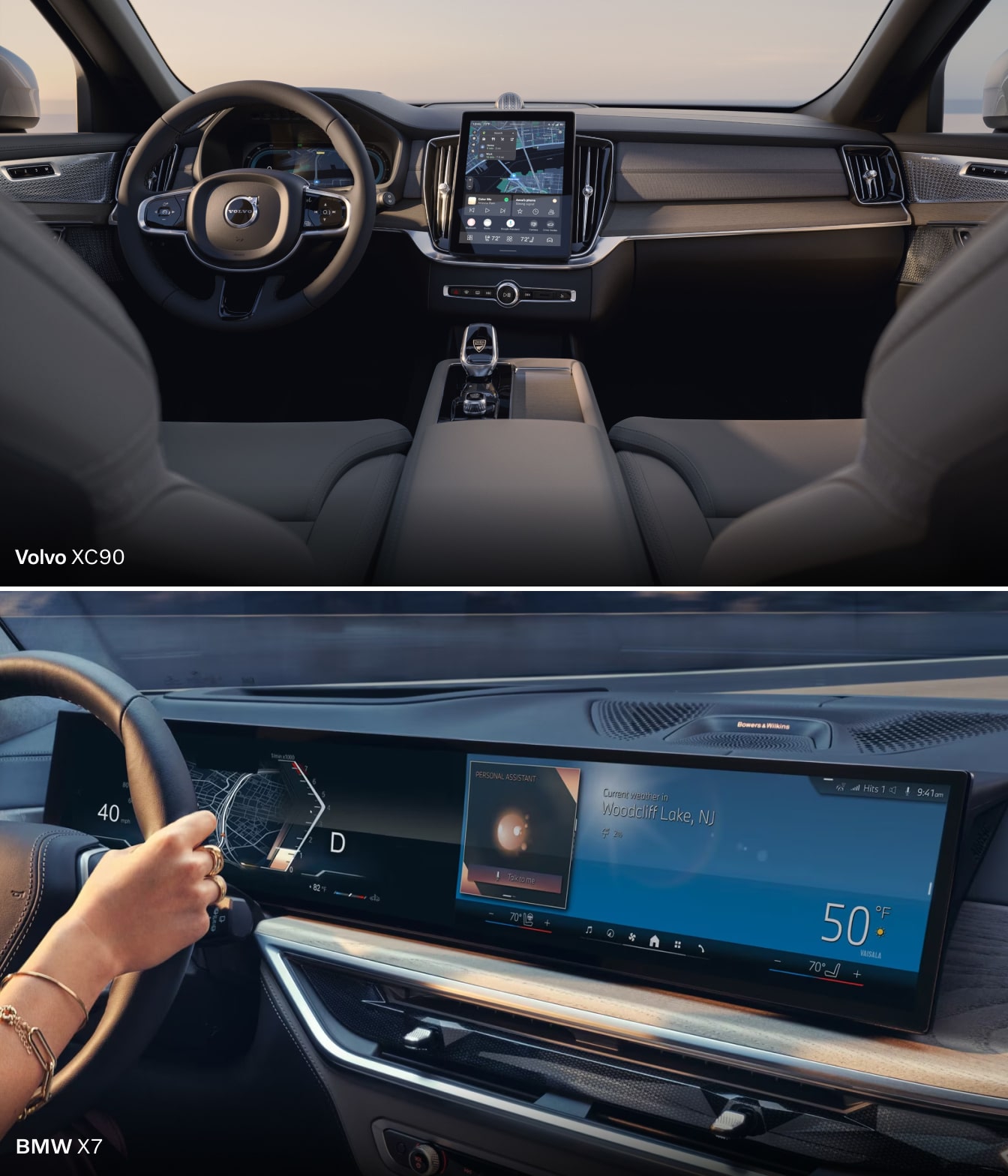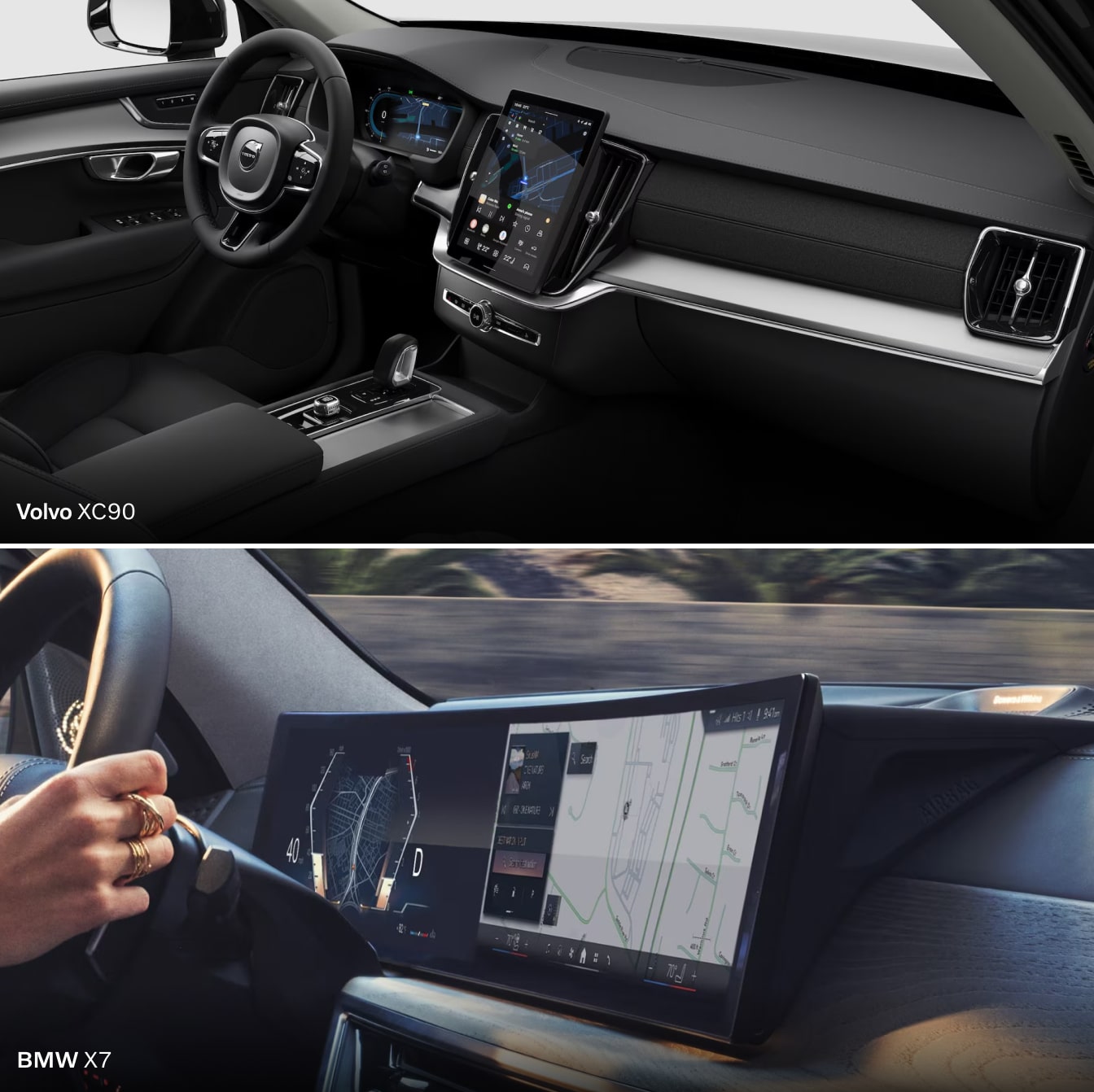Comparing The Volvo XC90 Vs. BMW X7

Choosing your next family-friendly luxury SUV can be a daunting task, which is why we put together this Volvo XC90 vs. BMW X7 comparison to showcase two popular models and determine which one comes out on top. Spoiler alert: The more expensive 2025 BMW X7 offers powerful engine options and a long list of features – yet the 2025.5 Volvo XC90 remains a better deal, with the efficient B5 and B6 powertrains and comparable (or more impressive) amenities at a more appealing starting MSRP.
Peruse our DARCARS Volvo Cars BMW X7 vs. Volvo XC90 review below. We touch on the major differences, such as performance, innovation, and more, so you can make an informed decision.

Volvo XC90 vs. BMW X7 Performance and Safety
When you step into the 2025 BMW X7, you expect a power-hungry engine that lets you burn rubber – and we admit, you do get one in the BMW X7 xDrive40i, pumping out 375 horsepower and 398 pound-feet of torque. That outdoes the 2025.5 Volvo XC90 B5's 247 horsepower and 266 pound-feet of torque and its B6's 295 horsepower and 310 pound-feet of torque. However, the Volvo XC90 PHEV outshines the base BMW model, achieving 455 horsepower and 523 pound-feet of torque, but it can't outpace the higher trims.
That extra power might seem appealing, but it comes at the expense of your gas bill. The BMW X7 xDrive40i lumbers down the road with an EPA-estimated 20/24/22 MPG (City/Highway/Combined).1 Meanwhile, the Volvo XC90 B5 engine gets an EPA-estimated 23/30/26 MPG (City/Highway/Combined).2 The truly stark difference comes as you ascend the trim lineups, though. The BMW ALPINA XB7 earns an EPA-estimated 17 MPG (Combined),1 dropping significantly from its base value.
On the other hand, the more powerful B6 powertrain for the Volvo XC90 gets an EPA-estimated 23 MPG (Combined).3 That's not even considering this model's plug-in hybrid variant – if you look at the 455-horsepower Volvo XC90 PHEV, you find an even more efficient powertrain rated at an EPA-estimated 58 MPGe (Combined).4
Stronger engines hardly mean better safety, though. The Volvo XC90 vs. BMW X7 share a few smart driver-assist systems. For instance, the 2025.5 Volvo XC90 boasts the Blind Spot Information System and Park Assist Camera as standard equipment; the 2025 BMW X7 has the same comparable amenities. However, the BMW X7 lacks standard offerings like Cross Traffic Alert, Hill Start Assist, Slippery Road Alert, and Oncoming Lane Mitigation, all of which are standard in the Volvo SUV.
With a starting MSRP over $20K more than the Volvo XC90,5, 6 you'd expect more in the way of safety performance from the BMW X7, but that's just not the case. Even as you climb the trim ladder, the more affordably priced Volvo XC90 keeps pace – even outdoes – the BMW X7 in terms of safety.

BMW X7 vs. Volvo XC90 Dimensions
As you inspect the cabin of both high-end SUVs, you notice similar dimensions – though the BMW X7 could be deemed the chunkier ride. These vehicles are seven-seat SUVs by default, and the BMW X7 has a length of 203.6 inches, a width of 78.7 inches, and a height of 72.2 inches. Meanwhile, the Volvo XC90 has a more maneuverable length of 195 inches, a width of 79.1 inches, and a height of 69.9 inches. They share somewhat comparable passenger space, with front-row riders enjoying an extra 1.1 inches of legroom and second-row passengers losing less than 1 inch of legroom in the Volvo XC90.
While the BMW X7 has a slightly bigger maximum cargo area – by only 4.7 cubic feet, to be precise – the Volvo XC90 provides better day-to-day cargo space. Your basic load compartment area with the third row down reaches 65 cubic feet. In the BMW X7, you may be disappointed with the 48.6 cubic feet of cargo space you get in the same configuration.

Volvo XC90 vs. BMW X7 Interior
We've talked about the space inside the cabin, but how do the other interior elements stack up in our Volvo XC90 vs. BMW X7 comparison? The BMW X7 xDrive401 uses Sensafin leatherette upholstery, while the new Volvo XC90 features quilted Nordico upholstery. Upgrade to the final configuration of each SUV for a premium leather interior: Nappa in the Volvo XC90 and Merino in the BMW X7.
The inside of the 2025.5 Volvo XC90 feels custom-crafted for you with its simplistic yet refined Scandinavian design. Whether you choose the Volvo XC90 or BMW X7, they boast some of the same standard amenities, including four-zone climate control, heated front seats, a panoramic roof (panoramic moonroof in the BMW X7), and keyless entry.
The Volvo XC90 does offer some features that don't come standard in the BMW X7 – or at all. For instance, it has a crystal gear selector knob by Orrefors® (a truly one-of-a-kind refinement that acts as a gorgeous centerpiece), illuminated sill molding, a humidity sensor, and a hidden storage compartment in the cargo area. If you're seeking an unparalleled luxury experience, the Volvo XC90 may be the answer.

BMW X7 vs. Volvo XC90 Technology
When you compare BMW X7 vs. Volvo XC90 technology, the more expensive vehicle surely wins the day, right? It depends. To start, both SUVs possess a 12.3-inch digital driver display, wireless charging, a 10-speaker audio system, and an auto-dimming rearview mirror. The 2025 BMW X7 features a 14.9-inch center display, which is slightly larger than the 11.2-inch display in the 2025.5 Volvo XC90. However, considering both systems offer similar levels of connectivity and navigation options, we don't think a larger infotainment display justifies the excessively higher starting MSRP of the BMW SUV in our Volvo XC90 vs. BMW X7 matchup.
Furthermore, the Volvo XC90 offers HomeLink® as standard equipment, which is not featured at all in the BMW X7. The higher trims for each model add amenities like a Harman Kardon® sound system, heated rear seats, and ventilated front seats. The Volvo XC90 also boasts a power cushion extender for the driver's seat, another item not available in the BMW SUV.
Explore the 2025.5 Volvo XC90 in Person at DARCARS Volvo Cars
Now that you know more about the Volvo XC90 vs. BMW X7, we're happy to show you even more ways the Volvo SUV stuns. Visit us and tour our new Volvo cars for sale and get behind the wheel of the Volvo XC90. Plus, our friendly Volvo financing department can help you find the Volvo XC90 lease or finance plan that fits your needs and budget.
Whether you want a six- or seven-seat SUV for the family or wish to explore our smaller models, the options in our showroom possess the same dedication to advanced features, exquisite design, and efficient performance as the 2025.5 Volvo XC90. We can't wait to see you drive home in the luxury SUV perfect for you and your family.
Frequently Asked Questions
Is the Volvo XC90 bigger than the BMW X7?
If you compare Volvo XC90 vs. BMW X7 size, the BMW X7 clocks in at 203.6 inches in length and 78.7 inches in width, while the Volvo XC90 provides 195 inches in length and 79.1 inches in width. This means the Volvo XC90 offers the same seating capacity of up to seven while remaining arguably more maneuverable than its competitor.
What is the difference in horsepower between the Volvo XC90 and the BMW X7?
The BMW X7 has more horsepower than the Volvo XC90, with 375 horsepower vs. 247 horsepower when comparing their base engines. However, this comes at the cost of fuel economy, with the BMW X7 xDrive40i earning an EPA-estimated 22 MPG (Combined),1 while the Volvo XC90 has an improved EPA-estimated 26 MPG (Combined).2 You may have to visit the gas station more often in the BMW X7.
What is the difference in seating between the Volvo XC90 and the BMW X7?
The Volvo XC90 and BMW X7 share similar seating arrangements. Both vehicles have two front seats, a three-seat second-row bench, and two third-row seats as standard. You have the option to upgrade to second-row captain's chairs in either model, lowering the seating capacity to six. The Volvo XC90 also provides more front legroom for a comfortable drive.
 AdChoices
AdChoices